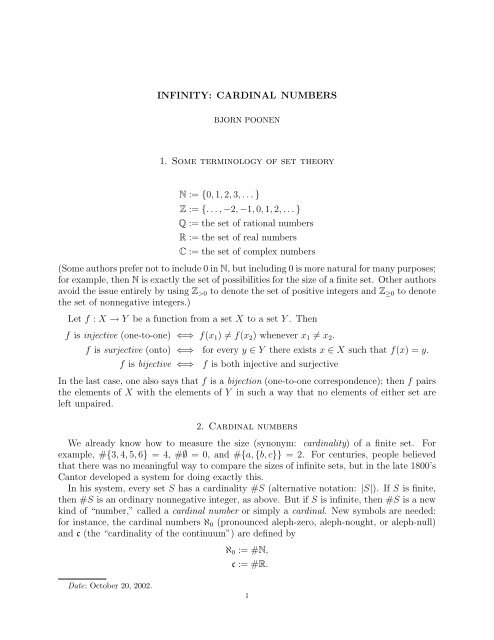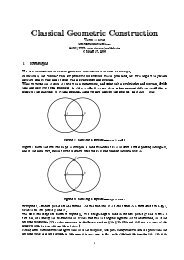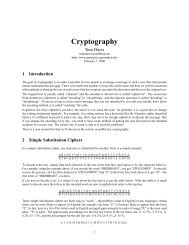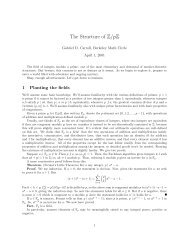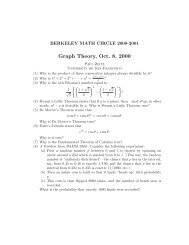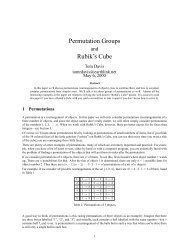INFINITY: CARDINAL NUMBERS 1. Some terminology of set theory ...
INFINITY: CARDINAL NUMBERS 1. Some terminology of set theory ...
INFINITY: CARDINAL NUMBERS 1. Some terminology of set theory ...
Create successful ePaper yourself
Turn your PDF publications into a flip-book with our unique Google optimized e-Paper software.
<strong>INFINITY</strong>: <strong>CARDINAL</strong> <strong>NUMBERS</strong><br />
BJORN POONEN<br />
<strong>1.</strong> <strong>Some</strong> <strong>terminology</strong> <strong>of</strong> <strong>set</strong> <strong>theory</strong><br />
N := {0, 1, 2, 3, . . . }<br />
Z := {. . . , −2, −1, 0, 1, 2, . . . }<br />
Q := the <strong>set</strong> <strong>of</strong> rational numbers<br />
R := the <strong>set</strong> <strong>of</strong> real numbers<br />
C := the <strong>set</strong> <strong>of</strong> complex numbers<br />
(<strong>Some</strong> authors prefer not to include 0 in N, but including 0 is more natural for many purposes;<br />
for example, then N is exactly the <strong>set</strong> <strong>of</strong> possibilities for the size <strong>of</strong> a finite <strong>set</strong>. Other authors<br />
avoid the issue entirely by using Z>0 to denote the <strong>set</strong> <strong>of</strong> positive integers and Z≥0 to denote<br />
the <strong>set</strong> <strong>of</strong> nonnegative integers.)<br />
Let f : X → Y be a function from a <strong>set</strong> X to a <strong>set</strong> Y . Then<br />
f is injective (one-to-one) ⇐⇒ f(x1) = f(x2) whenever x1 = x2.<br />
f is surjective (onto) ⇐⇒ for every y ∈ Y there exists x ∈ X such that f(x) = y.<br />
f is bijective ⇐⇒ f is both injective and surjective<br />
In the last case, one also says that f is a bijection (one-to-one correspondence); then f pairs<br />
the elements <strong>of</strong> X with the elements <strong>of</strong> Y in such a way that no elements <strong>of</strong> either <strong>set</strong> are<br />
left unpaired.<br />
2. Cardinal numbers<br />
We already know how to measure the size (synonym: cardinality) <strong>of</strong> a finite <strong>set</strong>. For<br />
example, #{3, 4, 5, 6} = 4, #∅ = 0, and #{a, {b, c}} = 2. For centuries, people believed<br />
that there was no meaningful way to compare the sizes <strong>of</strong> infinite <strong>set</strong>s, but in the late 1800’s<br />
Cantor developed a system for doing exactly this.<br />
In his system, every <strong>set</strong> S has a cardinality #S (alternative notation: |S|). If S is finite,<br />
then #S is an ordinary nonnegative integer, as above. But if S is infinite, then #S is a new<br />
kind <strong>of</strong> “number,” called a cardinal number or simply a cardinal. New symbols are needed:<br />
for instance, the cardinal numbers ℵ0 (pronounced aleph-zero, aleph-nought, or aleph-null)<br />
and c (the “cardinality <strong>of</strong> the continuum”) are defined by<br />
Date: October 20, 2002.<br />
ℵ0 := #N,<br />
c := #R.<br />
1
2 BJORN POONEN<br />
3. Equality <strong>of</strong> cardinal numbers<br />
We do not introduce a different symbol for every individual <strong>set</strong>, because sometimes two<br />
different <strong>set</strong>s can have the same size. For instance, two finite <strong>set</strong>s have the same size if<br />
and only if one <strong>set</strong> can be obtained from the other by relabeling the elements; for instance,<br />
{1, 2, 3} has the same cardinality as {a, b, c}. One <strong>of</strong> the fundamental properties <strong>of</strong> Cantor’s<br />
cardinal numbers is that the same should hold for arbitrary <strong>set</strong>s, finite or not. This can be<br />
reworded as follows:<br />
RULE 1: #S = #T ⇐⇒ there exists a bijection f : S → T .<br />
For instance, if S = {0, −1, −2, −3, . . . }, then #N = #S because there is a bijection<br />
N → S sending each nonnegative integer n to −n:<br />
0 ←→ 0<br />
1 ←→ −1<br />
2 ←→ −2<br />
3 ←→ −3<br />
.<br />
4. Comparing cardinal numbers<br />
RULE 2: #S ≤ #T ⇐⇒ there exists an injection f : S → T .<br />
Loosely speaking, S is smaller or equal in size to T if and only if one can match the elements<br />
<strong>of</strong> S with elements <strong>of</strong> T so that all elements <strong>of</strong> S get used (but maybe some elements <strong>of</strong> T<br />
are left over). For example, there is an injection {a, b, c} → N sending a to 1, b to 2, and c<br />
to 17; this proves that 3 ≤ ℵ0. As a special case <strong>of</strong> Rule 2, if S ⊆ T , then #S ≤ #T .<br />
The relations = and ≤ for cardinals satisfy the same properties as they do for ordinary<br />
numbers:<br />
(1) #S = #S for any <strong>set</strong> S (reflexivity).<br />
(2) If #S = #T , then #T = #S (symmetry).<br />
(3) If #S = #T and #T = #U, then #S = #U (transitivity).<br />
(4) If #S = #T , then #S ≤ #T .<br />
(5) If #S ≤ #T and #T ≤ #U, then #S ≤ #U (transitivity).<br />
(6) For any two <strong>set</strong>s S and T , either #S ≤ #T or #T ≤ #S.<br />
(7) If #S ≤ #T and #T ≤ #S, then #S = #T .<br />
The last two are fairly difficult to deduce from the definitions. The last one is called the<br />
Schröder-Bernstein Theorem; it says that if there exist injections S → T and T → S, then<br />
there exists a bijection S → T . (This appeared as a problem on one <strong>of</strong> the monthly contests.)<br />
The other relations like ≥, can be defined in terms <strong>of</strong> = and ≤. For instance,<br />
“#S > #T ” means “#T ≤ #S is true and #S = #T is false.”<br />
5. An unfortunate situation<br />
If S and T are finite <strong>set</strong>s, and S is a proper sub<strong>set</strong> <strong>of</strong> T (this means that S ⊆ T but<br />
S = T ), then #S < #T . Unfortunately, this is no longer true when we consider infinite <strong>set</strong>s!
<strong>INFINITY</strong>: <strong>CARDINAL</strong> <strong>NUMBERS</strong> 3<br />
For example, if S = {3, 4, 5, 6, . . . }, then S is a proper sub<strong>set</strong> <strong>of</strong> N, but according to the<br />
definition, #S = #N, because there is a bijection from S to N:<br />
3 ←→ 0<br />
4 ←→ 1<br />
5 ←→ 2<br />
6 ←→ 3<br />
.<br />
Moreover, this unfortunate situation is unavoidable if we want to keep Rules 1 and 2 (and<br />
we do). We just have to live with it.<br />
6. The cardinality <strong>of</strong> Z<br />
Suppose we want to check whether the <strong>set</strong> Z <strong>of</strong> integers has the same cardinality as N.<br />
If we try to <strong>set</strong> up a bijection from N to Z without thinking, we fail because the negative<br />
numbers are not used:<br />
0 ←→ 0<br />
1 ←→ 1<br />
2 ←→ 2<br />
3 ←→ 3<br />
.<br />
− 1, −2, −3, . . . are not used.<br />
This is only an injection. Does this mean that #N = #Z? No! Even though this function<br />
did not give a bijection, it is easy to construct other functions N → Z that are bijections,<br />
like<br />
0 ←→ 0<br />
1 ←→ 1<br />
2 ←→ −1<br />
3 ←→ 2<br />
4 ←→ −2<br />
5 ←→ 3<br />
6 ←→ −3<br />
.<br />
Thus #Z = #N = ℵ0, even though N is a proper sub<strong>set</strong> <strong>of</strong> Z. (This is similar to the situation<br />
in the previous section.)<br />
7. Countable <strong>set</strong>s<br />
We next show that there is no infinite <strong>set</strong> strictly smaller than N.<br />
Proposition <strong>1.</strong> If #S ≤ ℵ0, then either S is finite or #S = ℵ0.
4 BJORN POONEN<br />
Pro<strong>of</strong>. Start listing distinct elements <strong>of</strong> S:<br />
s0, s1, s2, s3, . . .<br />
If at some point we run out <strong>of</strong> elements, then S is finite. Otherwise we have constructed an<br />
injection N → S sending n to sn for each n ∈ N, so ℵ0 = #N ≤ #S. But #S ≤ ℵ0 was<br />
given, so in this case, #S = ℵ0. <br />
A <strong>set</strong> S is called countable if #S ≤ ℵ0, and S is called countably infinite if #S = ℵ0.<br />
According to our definition (which not all people agree on), finite <strong>set</strong>s like {1, 2, 3} and ∅<br />
also are considered to be countable.<br />
The following is an extremely useful tool for calculating cardinalities.<br />
Theorem 2 (Typewriter Principle). Let S be a <strong>set</strong>. If there is a way to label each element<br />
<strong>of</strong> S with a finite string <strong>of</strong> typewriter symbols (like fYe*4^!!!@) so that no two elements <strong>of</strong><br />
S are given the same label, then S is countable; i.e., #S ≤ ℵ0. If moreover S is infinite,<br />
then #S = ℵ0.<br />
Pro<strong>of</strong>. Let T be the <strong>set</strong> <strong>of</strong> all finite strings <strong>of</strong> typewriter symbols. There are fewer than 900<br />
typewriter characters, so we may assign each a three-digit code not beginning with 0. For<br />
instance, we might assign<br />
a ↦→ 100<br />
b ↦→ 101<br />
% ↦→ 486<br />
.<br />
Let strings <strong>of</strong> characters be mapped to the concatenation <strong>of</strong> the character codes; for instance,<br />
ba% would map to 101100486 ∈ N. This gives an injection T → N, so #T ≤ #N = ℵ0. The<br />
labelling <strong>of</strong> S gives an injection S → T , so #S ≤ #T ≤ ℵ0. The final statement follows<br />
from Proposition <strong>1.</strong> <br />
Proposition 3. #Q = ℵ0.<br />
Pro<strong>of</strong>. Each rational number can be labelled with a string <strong>of</strong> typewriter symbols representing<br />
it like -75/89, and Q is infinite, so the Typewriter Principle shows that #Q = ℵ0. <br />
An algebraic number is a complex number that is a zero <strong>of</strong> some nonzero polynomial with<br />
rational coefficients. A transcendental number is a complex number that is not algebraic.<br />
The <strong>set</strong> <strong>of</strong> algebraic numbers is denoted by Q. For instance, √ 2 ∈ Q, since √ 2 is a zero<br />
<strong>of</strong> x 2 − 2. On the other hand, it is true (but very difficult to prove) that π and e are<br />
transcendental.<br />
Proposition 4. #Q = ℵ0.<br />
Pro<strong>of</strong>. We can describe −i √ 2 as<br />
the complex zero <strong>of</strong> x^2+2 closest to -<strong>1.</strong>4i<br />
Similarly, each a ∈ Q can be singled out by a finite string <strong>of</strong> typewriter symbols giving a<br />
polynomial with rational coefficients <strong>of</strong> which it is a zero, together with an approximate<br />
description <strong>of</strong> its location to distinguish it from the other zeros <strong>of</strong> that polynomial. By the<br />
Typewriter Principle, #Q = ℵ0.
<strong>INFINITY</strong>: <strong>CARDINAL</strong> <strong>NUMBERS</strong> 5<br />
8. Arithmetic <strong>of</strong> cardinal numbers<br />
Suppose S = {1, 2} and T = {1, 2, 3}. Relabelling the elements <strong>of</strong> T yields a <strong>set</strong> T ′ =<br />
{a, b, c} <strong>of</strong> the same cardinality, but which is disjoint from T . Then 2 + 3 = #S + #T =<br />
#(S ∪ T ′ ) = #{1, 2, a, b, c} = 5. This observation lets one add cardinal numbers in general:<br />
if S and T are arbitrary <strong>set</strong>s then the sum <strong>of</strong> the cardinal numbers #S and #T is defined<br />
to be the cardinality <strong>of</strong> S ∪ T ′ where T ′ is obtained from T by relabeling elements so that<br />
S ∩ T ′ = ∅. For example, in the disjoint union<br />
all three <strong>set</strong>s are <strong>of</strong> cardinality ℵ0, so<br />
{0, 2, 4, 6, . . . } ∪ {1, 3, 5, 7, . . . } = N,<br />
ℵ0 + ℵ0 = ℵ0.<br />
The Cartesian product S × T <strong>of</strong> two <strong>set</strong>s S and T is the <strong>set</strong> <strong>of</strong> all ordered pairs (s, t) where<br />
s ∈ S and t ∈ T . For example, if S = {1, 2} and T = {a, b, c}, then<br />
S × T = {(1, a), (1, b), (1, c), (2, a), (2, b), (2, c)}<br />
so #(S × T ) = 6 = 2 · 3. If S and T are arbitrary <strong>set</strong>s, then the product <strong>of</strong> the cardinal<br />
numbers #S and #T is defined to be #(S × T ). For instance, the elements <strong>of</strong> N × N can<br />
be described by strings <strong>of</strong> typewriter symbols like (5,7), so the Typewriter Principle shows<br />
that #(N × N) = ℵ0. Therefore<br />
ℵ0 · ℵ0 = ℵ0.<br />
These equalities may look strange, but in fact, such behavior is typical: one can prove that<br />
if ℵ and ℵ ′ are cardinal numbers such that ℵ ≤ ℵ ′ and ℵ ′ is infinite, then ℵ + ℵ ′ = ℵ · ℵ ′ = ℵ ′ .<br />
There is no nice way <strong>of</strong> subtracting or dividing cardinal numbers. But one can exponentiate.<br />
If S and T are arbitrary <strong>set</strong>s, let S T denote the <strong>set</strong> <strong>of</strong> functions from T to S. Note<br />
the reversal <strong>of</strong> order! Then (#S) (#T ) is defined to be the cardinality <strong>of</strong> S T . For example, if<br />
S = N and T = {1, 2, 3}, then a sample element <strong>of</strong> S T might be described by<br />
the function {1,2,3}->N sending 1 to 12, 2 to 753, and 3 to 489.<br />
The Typewriter Principle shows that #(S T ) = ℵ0. Hence (ℵ0) 3 = ℵ0.<br />
9. The power <strong>set</strong><br />
The power <strong>set</strong> P(S) <strong>of</strong> a <strong>set</strong> S is the <strong>set</strong> <strong>of</strong> all its sub<strong>set</strong>s. For instance, if S = {1, 2, 3},<br />
then<br />
P(S) = {∅, {1}, {2}, {3}, {1, 2}, {1, 3}, {2, 3}, {1, 2, 3}},<br />
so #P(S) = 8.<br />
For any <strong>set</strong> S, there is a bijection between P(S) and the <strong>set</strong> {0, 1} S <strong>of</strong> functions χ : S →<br />
{0, 1} that maps the sub<strong>set</strong> T <strong>of</strong> S to its characteristic function<br />
χT (s) :=<br />
Therefore #P(S) = # {0, 1} S = 2 #S .<br />
<br />
1, if s ∈ T<br />
0, if s ∈ T<br />
.
6 BJORN POONEN<br />
10. Cantor’s diagonal argument<br />
Now consider the special case S = N. For convenience <strong>of</strong> notation, we may represent a<br />
function f : N → {0, 1} by a sequence <strong>of</strong> binary digits. For example, 1011101 · · · corresponds<br />
to the function f such that f(0) = 1, f(1) = 0, f(2) = 1, f(3) = 1, f(4) = 1, f(5) = 0,<br />
f(6) = 1, and so on.<br />
Lemma 5. There is no bijection between N and the <strong>set</strong> {0, 1} N <strong>of</strong> functions f : N → {0, 1}.<br />
Pro<strong>of</strong>. The pro<strong>of</strong> is by contradiction. Suppose, there is such a bijection, such as<br />
Then<br />
0 −→the function represented by 1011101 · · ·<br />
1 −→the function represented by 0011010 · · ·<br />
2 −→the function represented by 1100011 · · ·<br />
3 −→the function represented by 0011111 · · ·<br />
4 −→the function represented by 1110101 · · ·<br />
5 −→the function represented by 1000010 · · ·<br />
6 −→the function represented by 1010110 · · ·<br />
.<br />
the function represented by 0110001 · · · ,<br />
where the final sequence has been obtained by complementing the binary digits <strong>of</strong> the (highlighted)<br />
diagonal sequence, will not be in the list, since that last sequence differs from each<br />
sequence in the list at least in the highlighted digit. This contradicts the assumption that<br />
the mapping was a bijection. <br />
Theorem 6. ℵ0 < 2 ℵ0 .<br />
Pro<strong>of</strong>. There exists an injection N → {0, 1} N , for instance<br />
0 −→the function represented by 1000000 · · ·<br />
1 −→the function represented by 0100000 · · ·<br />
2 −→the function represented by 0010000 · · ·<br />
3 −→the function represented by 0001000 · · ·<br />
4 −→the function represented by 0000100 · · ·<br />
5 −→the function represented by 0000010 · · ·<br />
6 −→the function represented by 0000001 · · ·<br />
.<br />
so #N ≤ #{0, 1} N ; in other words ℵ0 ≤ 2 ℵ0 . But Lemma 5 shows that #N = #{0, 1} N , so<br />
ℵ0 = 2 ℵ0 . Combining these shows that ℵ0 < 2 ℵ0 . <br />
A similar pro<strong>of</strong> shows that ℵ < 2 ℵ for every cardinal number ℵ. In other words, the power<br />
<strong>set</strong> P(S) <strong>of</strong> a <strong>set</strong> S is always strictly bigger than S.
<strong>INFINITY</strong>: <strong>CARDINAL</strong> <strong>NUMBERS</strong> 7<br />
1<strong>1.</strong> The cardinality <strong>of</strong> R<br />
We already gave a name to #R, namely c, but in fact, this was unnecessary, since we’ll<br />
soon see that #R = 2 ℵ0 .<br />
Theorem 7 (Typewriter Principle II). Let S be a <strong>set</strong>. If there is a way to label each<br />
element <strong>of</strong> S with an infinite sequence <strong>of</strong> typewriter symbols (like a!b!c#d&· · · ) so that no<br />
two elements <strong>of</strong> S are given the same label, then #S ≤ 2 ℵ0 .<br />
Pro<strong>of</strong>. Assign each typewriter symbol a code <strong>of</strong> exactly 10 binary digits. Concatenating<br />
the codes in an infinite sequence <strong>of</strong> typewriter symbols yields an infinite sequence <strong>of</strong> binary<br />
digits. If we map each element <strong>of</strong> S to the corresponding binary digit sequence, we get an<br />
injection S → {0, 1} N . Hence #S ≤ #{0, 1} N = 2 ℵ0 . <br />
Theorem 8. We have #R = 2 ℵ0 ; in other words, c = 2 ℵ0 .<br />
Pro<strong>of</strong>. Any real number can be labelled by its decimal expansion, which is an infinite sequence<br />
<strong>of</strong> typewriter symbols like<br />
−386.589734957938798379579057 . . .<br />
so Typewriter Principle II implies that #R ≤ 2 ℵ0 . On the other hand there is an injection<br />
{0, 1} N → R sending each infinite sequence <strong>of</strong> 0’s and 1’s to the corresponding real number<br />
having those as the digits past the decimal point; for instance<br />
1011101110 . . . −→ .1011101110 . . . .<br />
This injection shows that #{0, 1} N ≤ #R; i.e., 2 ℵ0 ≤ #R. Combining these shows that<br />
#R = 2 ℵ0 . <br />
We showed earlier that the <strong>set</strong> Q <strong>of</strong> algebraic numbers had size only ℵ0, so the same is<br />
true for the real algebraic numbers. But ℵ0 < 2 ℵ0 = #R, so this shows that at least some<br />
real numbers are transcendental!<br />
12. The continuum hypothesis<br />
We showed in Proposition 1 that ℵ0 is the smallest infinite cardinal. It can be shown that<br />
there a next smallest cardinal called ℵ1; i.e., the only cardinals strictly smaller than ℵ1 are<br />
the finite ones and ℵ0. Next come ℵ2, ℵ3, . . . . Where does c = 2 ℵ0 = #R fit into this list, if<br />
anywhere? (A priori, it could be bigger than ℵn for every n ∈ N.) We know that 2 ℵ0 ≥ ℵ1,<br />
because we proved that 2 ℵ0 > ℵ0. Cantor conjectured<br />
Continuum Hypothesis: 2 ℵ0 = ℵ<strong>1.</strong><br />
In other words, he believed that there is no <strong>set</strong> whose cardinality is strictly between that <strong>of</strong><br />
N and that <strong>of</strong> R.<br />
In 1940 Gödel proved that the continuum hypothesis cannot be disproved from the other<br />
axioms <strong>of</strong> <strong>set</strong> <strong>theory</strong>. But in 1963 Cohen showed that it could not be proved from these<br />
axioms either!<br />
The role <strong>of</strong> the continuum hypothesis in <strong>set</strong> <strong>theory</strong> is similar to the role <strong>of</strong> the parallel<br />
postulate in plane geometry. The parallel postulate (that given a line L and a point P not<br />
on L, there exists a unique line L ′ through P that does not intersect L) cannot be disproved<br />
from the other axioms <strong>of</strong> plane geometry, because it is actually true for the euclidean model<br />
<strong>of</strong> geometry. On the other hand, the parallel postulate cannot be proved either, since it<br />
is false in various noneuclidean models <strong>of</strong> geometry which do satisfy all the other axioms.
8 BJORN POONEN<br />
Therefore the parallel postulate, or its negation, may be taken as a new axiom. Which one<br />
you choose will depend on your vision <strong>of</strong> what geometry is supposed to be.<br />
Similarly, whether you choose to accept the continuum hypothesis will depend on your<br />
idea <strong>of</strong> what a <strong>set</strong> is supposed to be.<br />
13. Problems<br />
There are a lot <strong>of</strong> problems here. Just do the ones that interest you.<br />
(1) Each <strong>of</strong> the following <strong>set</strong>s has cardinality equal to ℵ0, 2 ℵ0 , or 2 2 ℵ 0 . Determine which,<br />
in each case, and prove it.<br />
(a) {0, 1, 4, 9, 16, . . . }<br />
(b) Z[x] (the <strong>set</strong> <strong>of</strong> polynomials with integer coefficients)<br />
(c) Q[x] (the <strong>set</strong> <strong>of</strong> polynomials with rational coefficients)<br />
(d) R[x] (the <strong>set</strong> <strong>of</strong> polynomials with real coefficients)<br />
(e) C<br />
(f) The interval [0, 1] <strong>of</strong> real numbers between 0 and 1 inclusive.<br />
(g) The <strong>set</strong> <strong>of</strong> irrational real numbers.<br />
(h) The <strong>set</strong> <strong>of</strong> transcendental real numbers.<br />
(i) Z[i] := {a + bi : a, b ∈ Z} (the <strong>set</strong> <strong>of</strong> Gaussian integers)<br />
(j) The <strong>set</strong> <strong>of</strong> points in the plane.<br />
(k) The <strong>set</strong> <strong>of</strong> lines in the plane.<br />
(l) The <strong>set</strong> <strong>of</strong> functions from N to N.<br />
(m) The <strong>set</strong> <strong>of</strong> bijections from N to N.<br />
(n) The <strong>set</strong> <strong>of</strong> functions from N to R.<br />
(o) The <strong>set</strong> <strong>of</strong> functions from R to N.<br />
(p) The <strong>set</strong> <strong>of</strong> functions from R to R.<br />
(2) Prove properties 1 through 5 <strong>of</strong> cardinal numbers listed in Section 4 using only Rules<br />
1 and 2.<br />
(3) Let S and T be <strong>set</strong>s. Prove that if there exists a surjective function f : S → T , then<br />
#T ≤ #S.<br />
(4) Explain why our definition <strong>of</strong> (#S) (#T ) agrees with the usual definition for natural<br />
numbers when S and T are finite <strong>set</strong>s.<br />
(5) Show that ℵ ℵ0<br />
0 = 2 ℵ0 .<br />
(6) Show that #P(S) > #S for any <strong>set</strong> S. (Hint: try to rephrase Cantor’s diagonal<br />
argument purely in terms <strong>of</strong> <strong>set</strong> membership, without reference to sequences.)<br />
(7) Show that (α + β)γ = αγ + βγ for any three cardinal numbers α, β, and γ.<br />
c○Berkeley Math Circle<br />
Department <strong>of</strong> Mathematics, University <strong>of</strong> California, Berkeley, CA 94720-3840, USA<br />
E-mail address: poonen@math.berkeley.edu


